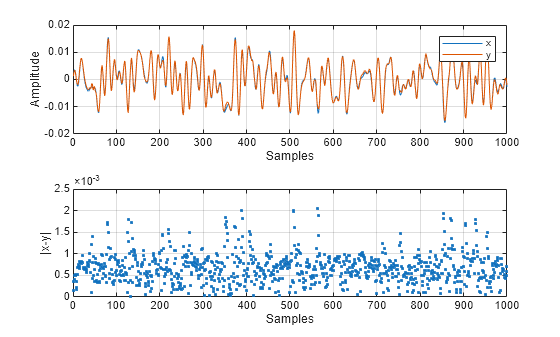Normalized Mean Squared Error as a Distance Measure
This example shows how to use the normalized mean squared error (NMSE) as a loss function for training a neural network in a wireless communications application.
Introduction
In wireless communications, accurately predicting signal behavior and performance is crucial for optimizing system design and operation. Neural networks have emerged as powerful tools for modeling and predicting complex relationships in communication systems. One critical aspect of training neural networks is the choice of the loss function, which guides the optimization process to minimize prediction errors.
The NMSE is an Euclidean distance measure similar to the mean squared error (MSE) . NMSE is particularly useful in scenarios where the scale of the data varies, as it normalizes the MSE by the variance of the target data, providing a scale-independent measure of prediction accuracy.
This example uses the helperNNDPDTrainingData function to generate data for the communications link. The signals x and y are the input and output of a power amplifier (PA). Ideally, the signals x and y should be the same, when the amplifier gain is removed. For more information see the Neural Network for Digital Predistortion Design-Offline Training example.
dpdData = helperNNDPDTrainingData; x = dpdData.txWaveTrain; y = dpdData.paOutputTrain;
Examine the signals.
plotSignals(x,y);

fprintf("The maximum amplitude of the signals is %f",max(max(abs(x)),max(abs(y))))The maximum amplitude of the signals is 0.020772
fprintf("The maximum absolute error between the two signals is %e",max(abs(x-y)))The maximum absolute error between the two signals is 2.052651e-03
fprintf("The average power of signal x is %e",mean(abs(x).^2))The average power of signal x is 7.787301e-05
Similarity Measures Based on Euclidean Distance
Measure the similarity of two signals using mean squared error (MSE) and normalized mean squared error (NMSE).
MSE Between Two Signals
MSE is defined as
.
mse = mean(abs(x-y).^2)
mse = single
5.6925e-07
In dB scale, MSE is
mse_dB = 10*log10(mse)
mse_dB = single
-62.4470
Since the amplitude and average power of signal x is small, MSE is also a very small number.
NMSE Between Two Signals
During training, small valued signals may not be taken into account as much as the larger valued signals. The NMSE loss function solves this problem by scaling the loss function with the signal power. The helperNMSE function implements the following equation and outputs NMSE in dB.
nmse = helperNMSE(x,y)
nmse = single
-21.3609
Train with NMSE and MSE
Train a neural network DPD using MSE and NMSE as loss function. Use the built in mse loss function and the custom helperNMSE function. First get the training options and the network using the helperNNDPDTrainingOptions function.
[net,options] = helperNNDPDTrainingOptions;
Set the random number generator to a known value to start training for both cases at the same initial conditions.
rng(123) netDPDMSE = trainnet(dpdData.trainingInput,dpdData.trainingOutput, ... net,"mse",options);
Iteration Epoch TimeElapsed LearnRate TrainingLoss
_________ _____ ___________ _________ ____________
1 1 00:00:00 0.001 3.4093
256 2 00:00:04 0.001 0.015105
512 4 00:00:06 0.001 0.0069223
768 6 00:00:08 0.00095 0.0043775
1024 8 00:00:10 0.00095 0.0025731
1280 10 00:00:12 0.00095 0.0014873
1536 12 00:00:14 0.0009025 0.001278
1792 14 00:00:16 0.0009025 0.0010231
2048 16 00:00:18 0.00085737 0.00078072
2304 18 00:00:20 0.00085737 0.00074962
2560 20 00:00:22 0.00085737 0.0007001
Training stopped: Max epochs completed
rng(123) netDPDNMSE = trainnet(dpdData.trainingInput,dpdData.trainingOutput, ... net,@(Y,T)helperNMSE(Y,T,"linear"),options);
Iteration Epoch TimeElapsed LearnRate TrainingLoss
_________ _____ ___________ _________ ____________
1 1 00:00:00 0.001 1.0841
256 2 00:00:07 0.001 0.014232
512 4 00:00:12 0.001 0.0053863
768 6 00:00:18 0.00095 0.0036059
1024 8 00:00:23 0.00095 0.0034171
1280 10 00:00:30 0.00095 0.0016647
1536 12 00:00:35 0.0009025 0.0015084
1792 14 00:00:40 0.0009025 0.0026097
2048 16 00:00:45 0.00085737 0.0011419
2304 18 00:00:50 0.00085737 0.0013903
2560 20 00:00:55 0.00085737 0.00099769
Training stopped: Max epochs completed
Compare the EVM, ACPR, MSE, and NMSE values of the trained networks.
dpdOutNMSE = predict(netDPDNMSE,dpdData.inputMtxTest); dpdOutNMSE = complex(dpdOutNMSE(:,1),dpdOutNMSE(:,2)); dpdOutNMSE = dpdOutNMSE/dpdData.scalingFactor; pa = helperNNDPDPowerAmplifier(DataSource="Simulated PA",SampleRate=dpdData.ofdmParams.SampleRate); paOutputNN = pa(dpdOutNMSE); % Evaluate performance with MSE loss function acprNMSE = helperACPR(paOutputNN,dpdData.ofdmParams.SampleRate,dpdData.ofdmParams.Bandwidth); nmseNMSE = helperNMSE(dpdData.txWaveTest,paOutputNN); mseNMSE = helperMSE(dpdData.txWaveTest,paOutputNN); evmNMSE = helperEVM(paOutputNN,dpdData.qamRefSymTest,dpdData.ofdmParams); dpdOutMSE = predict(netDPDMSE,dpdData.inputMtxTest); dpdOutMSE = complex(dpdOutMSE(:,1),dpdOutMSE(:,2)); dpdOutMSE = dpdOutMSE/dpdData.scalingFactor; paOutputNN = pa(dpdOutMSE); % Evaluate performance with NMSE loss function acprMSE = helperACPR(paOutputNN,dpdData.ofdmParams.SampleRate,dpdData.ofdmParams.Bandwidth); nmseMSE = helperNMSE(dpdData.txWaveTest,paOutputNN); mseMSE = helperMSE(dpdData.txWaveTest,paOutputNN); evmMSE = helperEVM(paOutputNN,dpdData.qamRefSymTest,dpdData.ofdmParams); results = table([evmMSE;evmNMSE],[acprMSE;acprNMSE],[mseMSE;mseNMSE],[nmseMSE;nmseNMSE], ... VariableNames=["EVM_percent","ACPR_dB","MSE_dB","NMSE_dB"],RowNames=["MSE Trained","NMSE Trained"])
results=2×4 table
EVM_percent ACPR_dB MSE_dB NMSE_dB
___________ _______ _______ _______
MSE Trained 2.0837 -33.795 -69.25 -28.139
NMSE Trained 1.7802 -35.346 -70.885 -29.774
Local Functions
function plotSignals(x,y) tiledlayout(2,1) nexttile plot(real(x(1:1000,1))) hold on plot(real(y(1:1000,1))) hold off grid on xlabel("Samples") ylabel("Amplitude") legend("x","y") nexttile plot(abs(x-y),'.') grid on xlabel("Samples") ylabel("|x-y|") end